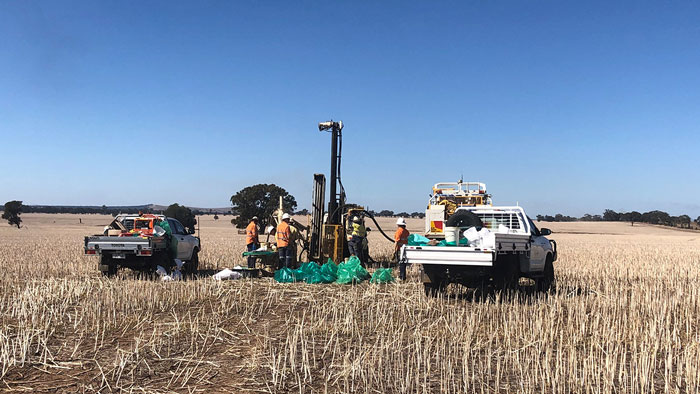North Stawell Minerals is lifting the skirt on ‘Victoria’s Secret’ in 2023

Pic: Via Getty Images
Finding gold under cover was considered too hard and too expensive for ‘old timer’ explorers in Victoria’s Stawell gold belt to even bother looking. But modern-day exploration techniques, especially geophysics, means 32Moz of undiscovered gold thought to be lurking below the Murray Basin cover in Victoria’s Stawell region can now be unlocked.
Victoria is well known as one of Australia’s most prolific gold producing regions and the Stawell belt in Western Victoria, together Bendigo and Ballarat form Victoria’s ‘Golden Triangle’. Of the 75Moz of gold to come out of the Golden Triangle, 6Moz has come from Stawell.
The true potential, however, of Stawell has long been hidden. In the north part of the Stawell Belt a blanket of sediment known as ‘Murray Basin cover’ has obscured and preserved gold-prospective geology.
Most modern exploration in Victoria has focused where historic mining has occurred. Historic mine occurrences in the Stawell region stop right where the Murray Basin cover begins – the covered terrain being too great an impediment for historic prospectors with unsophisticated techniques.
Victorian based North Stawell Minerals (ASX:NSM) has taken the approach that the best place to find the next multi-million-ounce mine is in the same region and nearby existing large operations.
In northern Victoria, for example, the untapped gold potential of the northern portion of the Stawell Corridor is an obvious target.
North Stawell Minerals has its foot on 504sq.km of ground that includes the same structures and geology that form the foundation of the 5Moz Stawell Gold Mine (SGM), immediately to the south of North Stawell’s ground.
SGM was once the state’s premier gold producer, before Fosterville, just east of Bendigo, came into production.
The gold-prospective Stawell corridor geology and structures ‘disappear’ under Murray Basin cover only 6km north of SGM. Cover depths slowly increase to the north – typically 20-50m – up to 100m in the north of North Stawell’s tenements. Thanks to modern exploration techniques North Stawell can now, for the first time, lift the skirt on Victoria’s secret.
Spoiled for choice
Geophysics has played a big part in North Stawell’s aggressive exploration program to unearth the next multi-million-ounce mine in the Stawell region. That’s because it can detect mineralisation-related basalts through the Murray Basin cover.
These ‘Magdala-style’ gold mineralised basalt domes, so called for the key basalt dome that hosts most of the gold at SGM, are geophysically responsive. This is a critical difference to other Victorian mineralisation.
Geophysics easily “looks” through cover, and North Stawell’s exploration strategy is to exploit the geophysics-responsive Magdala dome style basalt units that form the core to Stawell-type mineralisation and to efficiently vector towards multi-million-ounce potential.
And for North Stawell, this has successfully identified over 60 potential targets.
The company recently secured a $50,000 grant from the Australian government-backed CSIRO to work on identifying gold mineralisation pathways from geophysics data, which has the potential to significantly accelerate its exploration focus and success using regional data.
Geophysics-driven phase 1 drilling tested 18 of 20 priority targets at the company’s north Stawell tenement package, and phase 2 drilling has just started to test eight of the best prospects to come out of the initial drilling.
Wallis Drilling is mobilising its rig to site in preparation for phase-two drilling.

These targets have shown sufficient strike and potential to host extensive, shallow mineralisation similar to the 5Moz Stawell mine.
2023 is shaping up to be a big year for North Stawell as it leverages the geophysics insights and prior drilling to appraise targets unknown and unidentifiable until now. The Company is undertaking 12,500 to 15,000m of aircore drilling followed by diamond drilling starting in the south at the Germania prospect and heading north.
CEO Russell Krause told Stockhead the drilling would take about four months, with a second aircore rig to be mobilised to site in January.
Importantly, North Stawell has sufficient funding, with just under $6m in the bank at the end of the September quarter, to effectively test all of the planned targets in 2023.
The near-surface, covered mineralisation potential in the northern Stawell Corridor won’t be “Victoria’s Secret” for much longer.
This article was developed in collaboration with North Stawell Minerals, a Stockhead advertiser at the time of publishing.
This article does not constitute financial product advice. You should consider obtaining independent advice before making any financial decisions.
Related Topics

SUBSCRIBE
Get the latest breaking news and stocks straight to your inbox.
It's free. Unsubscribe whenever you want.
By proceeding, you confirm you understand that we handle personal information in accordance with our Privacy Policy.








